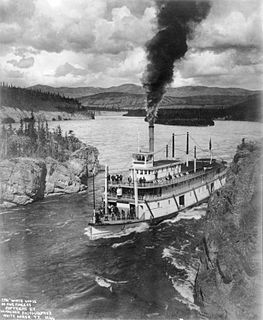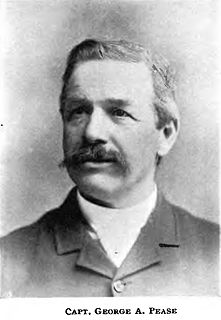Related Research Articles

A steamboat is a boat that is propelled primarily by steam power, typically driving propellers or paddlewheels. Steamboats sometimes use the prefix designation SS, S.S. or S/S or PS ; however, these designations are most often used for steamships.

Nathanael Greene Herreshoff was an American naval architect, mechanical engineer, and yacht design innovator. He produced a succession of undefeated America's Cup defenders between 1893-1920.

The Fall River Line was a combination steamboat and railroad connection between New York City and Boston that operated between 1847 and 1937. It consisted of a railroad journey between Boston and Fall River, Massachusetts, where passengers would then board steamboats for the journey through Narragansett Bay and Long Island Sound to the line's own Hudson River dock in Manhattan. For many years, it was the preferred route to take for travel between the two major cities. The line was extremely popular, and its steamboats were some of the most advanced and luxurious of their day.
The Long Island Rail Road is a railroad owned by the Metropolitan Transportation Authority in the U.S. state of New York. It is the oldest United States railroad still operating under its original name and charter. It consolidated several other companies in the late 19th century. The Pennsylvania Railroad owned the Long Island Rail Road for the majority of the 20th century and sold it to the State in 1966.

The Coos Bay Mosquito Fleet comprised numerous small steamboats and motor vessels which operated in the late 19th and early 20th centuries on Coos Bay, a large and mostly shallow harbor on the southwest coast of the U.S. state of Oregon, to the north of the Coquille River valley. Coos Bay is the major harbor on the west coast of the United States between San Francisco and the mouth of the Columbia River.

The Hunt Brothers were the owners of a steamboat business that ran on Puget Sound as part of the Puget Sound Mosquito Fleet. Five of the seven Hunt children became owners, engineers and masters of steamboats, these were Emmett E., Arthur.M., A.R, L.B., and F.M. Hunt.

The Greyhound was an express passenger steamer that operated from the 1890s to about 1915 on Puget Sound in Washington, United States. This vessel, commonly known as the Hound, the Pup, or the Dog, was of unusual design, having small upper works, but an enormous sternwheel. Unlike many sternwheelers, she was not intended for a dual role as passenger and freighter, but was purpose-built to carry mostly passengers on express runs.

Wilson G. Hunt was a steamboat that ran in the early days of steam navigation on Puget Sound and Sacramento, Fraser, and Columbia Rivers. She was generally known as the Hunt during her years of operation. She had a long career on the west coast of the United States and Canada, and played an important transportation role in the California Gold Rush; it also transported the Governor and the state legislature as the state capital of California moved from Benicia to Sacramento in 1854.

The sidewheeler Idaho was a steamboat that ran on the Columbia River and Puget Sound from 1860 to 1898. There is some confusion as to the origins of the name; many historians have proposed it is the inspiration for the name of the State of Idaho. Considerable doubt has been cast on this due to the fact that it is unclear if the boat was named before or after the idea of 'Idaho' as a territory name was proposed. John Ruckel also allegedly stated he had named the boat after a Native American term meaning 'Gem of the Mountains' he got from a mining friend from what is now Colorado territory. This steamer should not be confused with the many other vessels of the same name, including the sternwheeler Idaho built in 1903 for service on Lake Coeur d'Alene and the steamship Idaho of the Pacific Coast Steamship Line which sank near Port Townsend, Washington.

Richmond Hill is a closed station on the Montauk Branch of the Long Island Rail Road in the Richmond Hill neighborhood of Queens in New York City. The station is located at Myrtle Avenue and cuts diagonally from the intersection of Jamaica Avenue and Lefferts Boulevard through to Hillside Avenue. The station has two tracks and an island platform. Richmond Hill was the only station on the Lower Montauk Branch that was elevated with a high-level platform for passengers to wait for trains; the others were at ground level, with low-level platforms.

Steamboats on the Yukon River played a role in the development of Alaska and Yukon. Access to the interior of Alaska and Yukon was hindered by large mountains and distance, but the wide Yukon River provided a feasible route. The first steamers on the lower Yukon River were work boats for the Collins Overland Telegraph in 1866 or 1867, with a small steamer called Wilder. The mouth of the Yukon River is far to the west at St. Michael and a journey from Seattle or San Francisco covered some 4,000 miles (6,400 km).

The river sternwheeler Ramona operated from 1892 to 1908 on the Willamette River in Oregon, on the Stikine River running from Wrangell, Alaska into British Columbia, and the Fraser River, in British Columbia. This vessel should not be confused with the coastal steamship Ramona which also ran in Alaskan waters.

The steamboat Shoalwater was the sixth steamer to operate on the upper Willamette River, which refers to the part of the river above Willamette Falls at Oregon City. In a short career of six years, Shoalwater was renamedFenix, Franklin, and Minnie Holmes. Shoalwater was the first steamboat in Oregon to suffer a boiler explosion, although no fatalities resulted.

Crest was a wooden steamboat that operated on Puget Sound in the early 1900s. Following a sale of the vessel in May, 1912, this boat was known as Bay Island.

Lady of the Lake was a wooden steamboat that operated on Puget Sound from 1897 to 1903. Following a fire in 1903, the vessel was rebuilt as the tug Ruth.

Joseph Fahys was one of the first U.S. watch case manufacturers. After emigrating from France, he went on to establish Joseph Fahys & Co., which at one time was the largest manufacturer of watch cases and one of the largest manufacturers of silverware in the United States. He was also the founder and first president of the Jewelers' Board of Trade, and the first president of the Watchcase Manufacturers' Association.
Henry Francis Cook was a US manufacturer and financier. He was born in Brooklyn, New York. Cook was president of the Montauk Steamboat Company, the Sag Harbor Real Estate Company, and the Sag Harbor Water Company. He was vice-president of the Peconic Bank of Sag Harbor, secretary and treasurer of the Sag Harbor Heating and Lighting Company, and a partner in the Fahys Watch Case Company. He was a member of the Sons of the Revolution, Society of Colonial Wars, Pilgrims Society, Chamber of Commerce of the State of New York, Brooklyn Institute of Arts and Sciences, and the Union League Club. In 1883, he married Lena Marianne Fahys (1871–1936), the daughter of Joseph Fahys. Their children were Edith Eloise, Joseph Fahys, Madeline Huntting, Henry Cook (Harry), Francis Howell and Maria Fahys.

Ocean Wave was a steamboat that was operated from 1891 to 1897 on the Columbia River, from 1897 to 1899 on Puget Sound and from 1899 to 1911 as a ferry on San Francisco Bay. Ocean Wave is perhaps best known for transporting summer vacationers from Portland, Oregon to seaside resorts near Ilwaco, Washington during its service on the Columbia River. This vessel is also known for being the first ferry placed in service by the Atchison, Topeka and Santa Fe Railway.

George Anson Pease was a well-known steamboat captain in the Pacific Northwest region on the United States, who was active from the earliest days of steamboat navigation on the Willamette River in the 1850s. He worked in various roles until the early 1900s, commanding numerous vessels during that time. During a flood in 1861, while in command of the sternwheeler Onward, Pease rescued 40 people from a flood in the area of Salem, Oregon.

Steam navigation on Lake Coeur d'Alene lasted from the 1880s to the 1930s. More steamboats operated on Lake Coeur d’Alene than on any other lake west of the Great Lakes. The high point of steam navigation was probably from 1908 to 1913. After that railroads, and increasingly automobile and truck traffic on newly built highways supplanted steam navigation, although some vessels continued to be operated until the mid-1930s.
References
- 1 2 Ross, Peter (1903). A history of Long Island: from its earliest settlement to the present time (Public domain ed.). The Lewis publishing company. pp. 70–. Retrieved 13 November 2011.
- ↑ Marine engineering (Public domain ed.). Marine Publishing Company. 1902. pp. 490–. Retrieved 13 November 2011.
- ↑ Hamersly, Lewis Randolph (1904). Who's who in New York (city and state). Who's who publications, inc. pp. 144–. Retrieved 9 November 2011.
- ↑ "MONTAUK BOAT LINE SOLD; Passes Into the Control of the Long Island Railroad. RATES LIKELY TO BE RAISED Has Been Sharp Competition Between the Two Companies -- Railroad to Take Possession May 25" (PDF). The New York Times . May 14, 1899. Retrieved 14 November 2011.
- ↑ National Marine Engineers' Beneficial Association (U.S.) (1906). The American marine engineer (Public domain ed.). pp. 24–. Retrieved 13 November 2011.